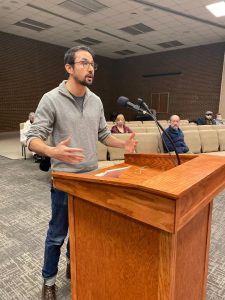
By Callie Hietala
A special use permit for a new solar project has been approved by the Board of Zoning Appeals. The project was previously rejected after a marathon 4-hour meeting on Nov. 24, 2021, but the applicant refiled with some major changes to the proposal.
Warren Sakey, the project development manager for Rocky Ford Solar, LLC, said the company was seeking to construct a large-scale, 90-megawatt facility in the Axton community on approximately 378 acres in the northeast vicinity of Mountain Valley Road and Dees Road and along Summerset Drive and Rufus Road.
Sakey told the board that Invenergy, the developer behind Rocky Ford Solar, “is the largest developer of renewable energy projects in North America” and that the company began its Axton project in 2019.
He said the company worked to address many of the concerns brought up by Axton residents and by Henry County Director of Planning, Zoning, and Inspections Lee Clark during the November meeting, including the noise created by construction, view shed once construction is completed, and the county’s density ordinance.
Sakey said his team completed a noise impact study, which shows where sound will affect neighboring properties. The study, he said, will allow the company to coordinate with residents and work with their schedules. He added the use of technology was explored, including mobile sound barriers, to deflect sound during construction.
In response to concerns about view shed, and particularly in response to previous concerns expressed by the owners and patrons of Axton-based brewery Mountain Valley Brewing which relies heavily on its views, Sakey told the board that engineers redesigned the project to encompass less than half of the initially requested acreage.
“This project is almost entirely screened from public view by existing forested areas,” Sakey said. “Most people will never know this project exists.” Additionally, the project redesign avoids placing a single panel on the fields behind the brewery.
In response to concerns about the density threshold, Sakey said that, in just a few months, the company has reduced the size of the project footprint by more than half that requested in the previously rejected permit, which was for the development of approximately 800 acres.
Sakey told the board that the company plans to plant native grasses and wildflowers to “turn this area into a pollinator habitat” with apiaries co-located with the project for honey production. Also, he said, the company has talked with landowners about the possibility of using solar grazing, which he described as the use of sheep for vegetation management. In short, the company is “to the maximum extent possible trying to do dual use to maximize agricultural value with this land, even though it’s going to be in solar.”
Sakey said the project is expected to bring in millions of dollars of tax revenue over its life, to create hundreds of jobs during construction and “a handful of lasting, good-paying jobs for operations during the life of the facility.”
Several people, including Herb Atwell, co-owner of Mountain Valley Brewing who previously spoke in opposition to the project, expressed support of the special use permit. Only one person, James Roberts, rose to speak in opposition, urging a delay in approval for an in-depth analysis of how the area would be economically impacted by the solar farm.
BZA chairman Manker Stone congratulated Sakey and Invenergy on the quality of the new proposal. He said “if we do vote to approve this, we are specifically dealing with the land use. Any nuts and bolts of the solar (aspects) that Henry County has laid out, all of that will have to be taken care of in the Zoning Administrator’s office” which is under Clark’s purview.
Clark, too, complimented Sakey.
“I’ve dealt with a lot of different solar companies … I’ve heard what these folks (Invenergy) have said, and I’ve experienced first-hand from working with the company, I’ve been impressed. They do what they say. They have done everything that I asked of them, they went over and above in some regards.”
“We can definitely see they’ve done their homework,” said BZA member Sandra Adams.
Ultimately, Paul Setliff made a motion to approve the proposal with several conditions:
* The company must “substantially comply with the submitted conceptual layout … including setbacks, conservation easements, areas not to be developed with panels, and vegetative buffer areas.”
* “Additional screening shall be provided in substantial accordance with submitted materials” in locations that are not already shielded by naturally occurring forested areas.
* The final site plan must comply with the county’s density requirements.
* “To help mitigate construction noise, a plan for the use of sound dampening curtains or some other method must be submitted and approved by the director prior to commencement of pile driving activities.”
The motion passed 3-0 (two board members did not attend the meeting.)
The next steps for the project are engineering and planning for the final design, Clark said. The preparation aspect of preparing the necessary plans and completing surveys could take 1-2 years. “It’s a long process,” he said. “I don’t expect to see poles going into the ground for potentially a couple of years.”
“That density ordinance is still an issue, so there is still more work to be done by the company,” he said. “That will be handled during the site plan review,” he said. “The conceptual plan that was submitted to the BZA is a huge step in the right direction, but I can’t say for sure until I get a final site plan as to whether they’re within that threshold or not.”
Clark said his office will be responsible for ensuring the company adheres to the promises they made to the board during their presentation. “I will make 100 percent certain that they do adhere to those conditions,” he said.




